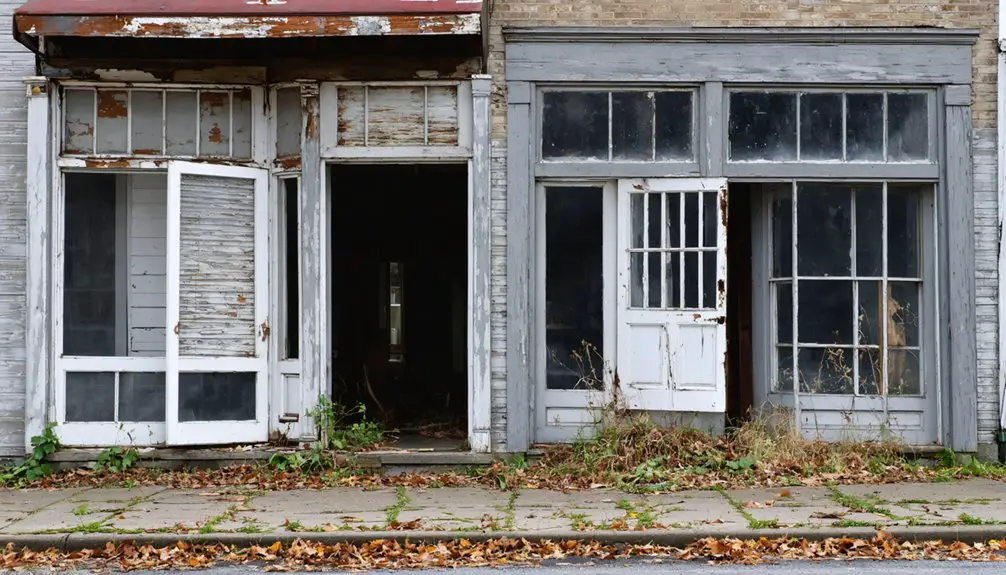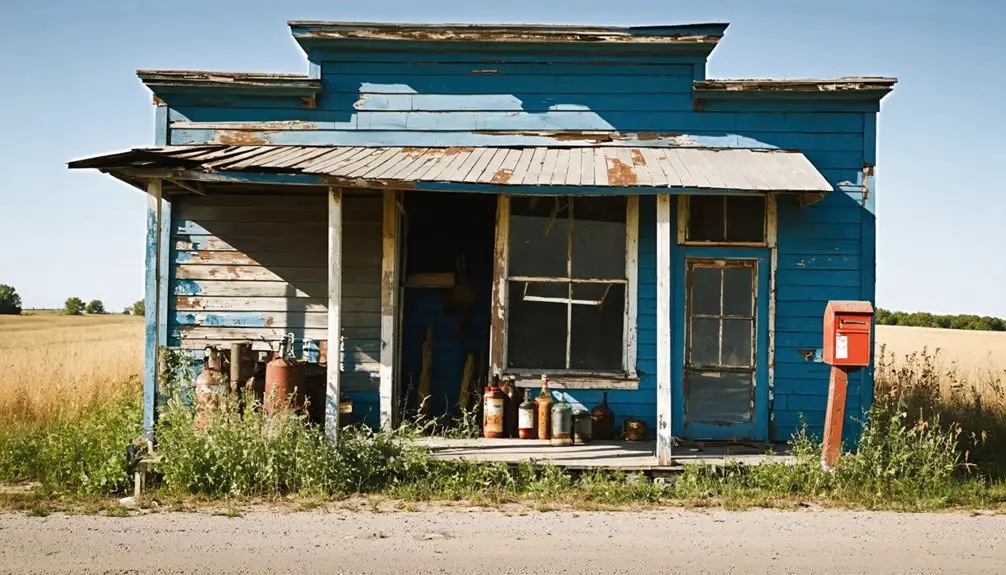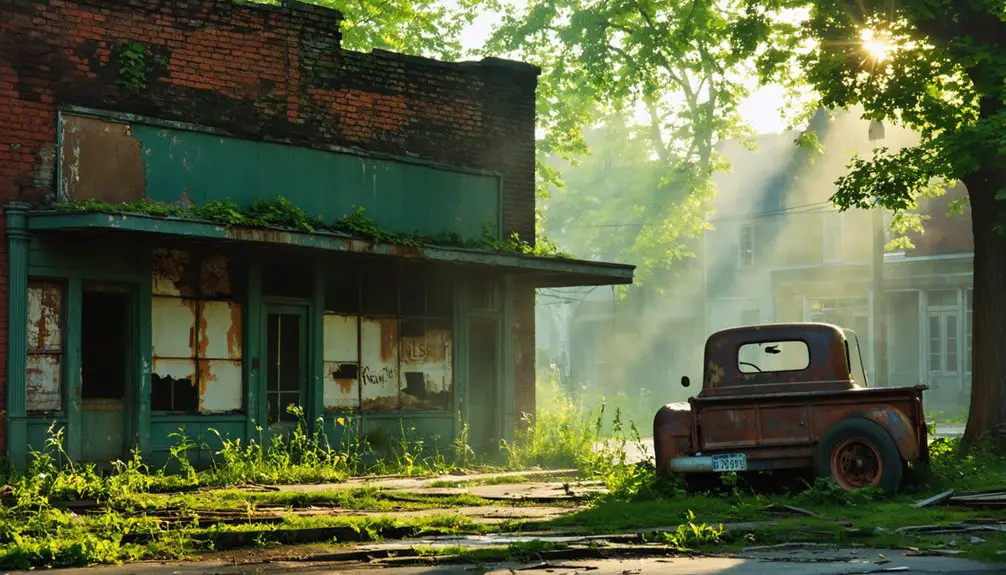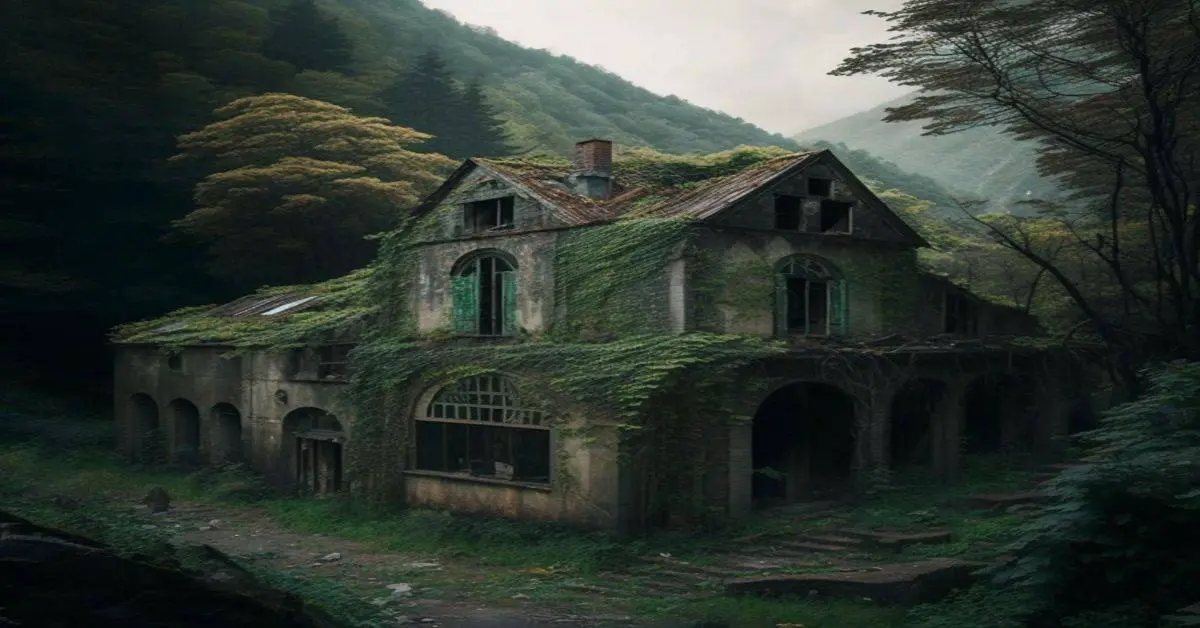You’ll find Henry Ford’s ambitious industrial experiment in Pequaming, Michigan, where he transformed a thriving 1870s lumber town into a model workers’ community in 1919. His vision included modern amenities, strict social rules, and innovative manufacturing processes, all while paying workers $5 per day. Though abandoned by the 1950s, you can still explore the weathered ruins along Lake Superior’s shore, where factory foundations and historic structures reveal fascinating stories of Ford’s utopian dream.
Key Takeaways
- Ford’s Pequaming mill town in Michigan declined from over 1,000 residents to virtual abandonment by the 1950s after operations ceased.
- The town featured company-built homes, tree-lined streets, and a 30-room mansion along Lake Superior’s shoreline.
- Workers lived in standardized model homes with modern amenities, following strict company rules about lifestyle and behavior.
- Historical remnants include mill foundations, factory ruins, and weathered wood-frame structures near water sources.
- The site exemplifies early 20th-century industrial town planning with integrated manufacturing, housing, and community facilities.
The Rise of Pequaming as a Lumber Empire
As the lumber industry boomed in Michigan’s Upper Peninsula during the late 1870s, entrepreneurs Edward and Charles Hebard, along with H.C. Thurber, established what would become the region’s largest lumber operation.
With an initial investment of two million dollars, they transformed Pequaming into a thriving company town.
You’ll find the scale of their enterprise was remarkable – they controlled 100,000 acres of forestland and achieved annual lumber production of 25 million feet, plus another 25 million shingles.
The operation employed nearly 1,000 workers who lived in company-owned homes and shopped at the company store.
The Hebards didn’t stop there – they developed the town with tree-lined streets and built an impressive 30-room mansion in southern plantation style along Lake Superior’s shore, showcasing the immense wealth their lumber empire generated.
When the virgin timber was depleted, the company made a successful transition to hardwood in 1904 to keep the mill operational.
In 1919, the property caught the attention of automotive pioneer Henry Ford, who purchased the land and mill to establish self-sufficient manufacturing operations for his growing automobile company.
Ford’s Vision for a Model Industrial Town
You’ll find Henry Ford’s vision for industrial towns reflected his belief in combining work, residence, and recreation into self-contained communities designed to boost worker loyalty and productivity.
His blueprint included American-style houses separated by class, along with modern amenities like hospitals, schools, and recreational facilities that would create an idealized company town environment. Drawing from his Village Industries model, Ford ensured these communities had access to small-scale manufacturing opportunities.
Ford’s social engineering extended beyond mere housing to shape workers’ lifestyles through planned social infrastructure, making the community a tool for promoting both industrial efficiency and his vision of proper American living standards. The strict implementation of his rules led to the infamous Breaking Pans revolt when workers protested against dietary restrictions in the cafeteria.
Ford’s Social Engineering Dream
While many company towns emerged during America’s industrial age, Henry Ford’s vision for the Brazilian settlement of Henry went far beyond typical worker housing.
You’ll find his ambitious social engineering experiment aimed to create a perfectly controlled industrial community, complete with strict social control measures and community isolation to shape worker behavior.
Similar to his Village Industries program in Michigan, Ford believed in combining industrial work with traditional rural lifestyles.
The sawmill at Alberta produced 14,000 board-feet of hardwood per day but struggled to maintain year-round operations.
Ford’s master plan included:
- Segregated American-style housing that physically separated Brazilian workers from American managers
- Carefully designed facilities for health, education, and structured leisure activities to regulate daily life
- Limited transportation access via river-only routes to maintain tight control over the population
You’d discover every aspect of life was meant to align with Ford’s values – from prescribed social norms to regimented work schedules starting at 5 a.m. for rubber harvesting.
Community Planning and Design
Beyond his dreams of social control, Henry Ford’s industrial town planning vision embodied a revolutionary fusion of factory efficiency and community design.
You’ll find his design principles reflected in every aspect of these self-contained communities, where factories seamlessly integrated with civic spaces, parks, and essential services.
Ford’s architects, led by Albert Kahn, created light-filled industrial buildings that defied the dark, cramped factories of the era. The iconic Crystal Palace facility showcased this revolutionary architectural approach. The principle was evident in his late Victorian style factory on Piquette Avenue, which emphasized natural lighting and efficient design.
The community engagement spaces featured parks and gathering places strategically positioned near both work and residential areas.
You’d notice how the town’s infrastructure worked as one organism – centralized utilities served both industrial and residential needs, while transportation arteries connected everything efficiently.
Even waste management showed innovation, with factory byproducts repurposed into new products, reflecting Ford’s vision of sustainable industrial communities.
Worker Housing and Benefits
Ford’s extensive vision extended far beyond factory walls into the domain of worker housing and benefits. You’ll find his commitment to worker welfare reflected in the establishment of the Dearborn Realty and Construction Company in 1919, which revolutionized housing affordability through assembly-line construction methods. Ford developed homes on Park Street for middle-class managers to foster loyalty and community among employees.
Here’s what made Ford’s housing initiative remarkable:
- Homes featured thoughtful designs with three bedrooms, fireplaces, and optional garages – luxuries typically beyond workers’ reach.
- Factory-style construction crews specialized in specific tasks, from basement digging to interior finishing.
- Bulk purchasing and on-site parts fabrication kept costs down while maintaining quality.
During WWII, this vision expanded to include Willow Run’s massive housing project, featuring dormitories for 3,000 workers and 2,500 family units, ensuring continuous production for the war effort. The project was specifically designed to address the urgent need to house 42,000 plant workers who were essential to the bomber production facility.
Daily Life in Ford’s Social Experiment
You’d have found Ford’s model homes in Henry to be meticulously planned single-family dwellings featuring modern amenities like indoor plumbing and electricity, while adhering to his vision of moral living through features such as front porches for socializing.
The community rules required workers to maintain their properties, attend church regularly, and abstain from alcohol, but in return they enjoyed company-sponsored activities and social clubs.
Workers and their families participated in community events at the town hall, sporting contests at the athletic fields, and educational programs at the community center – all carefully orchestrated to foster Ford’s ideal of productive, wholesome living.
Ford’s Model Home Design
When designing homes for his workers in Henry, Albert G. Wood created seven standardized models (A through F) that balanced housing efficiency with architectural variety.
You’ll find these two-story homes featured modern amenities rare for worker housing of that era, including indoor bathrooms, electricity, and telephone wiring. The design principles emphasized both practicality and modest comfort for working families.
Here’s what made these model homes stand out:
- You could choose between brick or wood exteriors, allowing for personal preference while maintaining mass-production efficiency.
- The homes featured varied roof styles – hip, gable, gambrel, and jerkin-head – creating visual diversity.
- Each home’s interior centered around a practical floor plan with social spaces downstairs and private family bedrooms upstairs.
The model aesthetics reflected early 20th-century suburban ideals while prioritizing affordability and quality construction.
Community Rules and Benefits
Beyond the thoughtfully designed homes, life in Henry demanded strict adherence to Ford’s vision of an ideal society.
You’d find your private life under constant scrutiny from Ford’s Social Department, which monitored everything from your drinking habits to your savings account.
While the community rules were strict – no alcohol, no farm animals, and mandatory garden cultivation – you’d receive significant social benefits in return.
Your wages would jump from $3.50 to $5.00 per day, with potential for another dollar raise after three months of proven reliability.
You’d enjoy modern amenities like electricity, running water, and indoor plumbing, plus access to University of Michigan-accredited education.
The trade-off? Your personal freedom for Ford’s promise of a better standard of living.
Workers’ Social Activities
- You’d attend company-sponsored English classes if you were an immigrant, helping you assimilate into the culture while improving workplace communication.
- Your family would participate in wholesome social activities that kept you away from perceived vices like gambling and alcohol.
- You’d need to demonstrate your embrace of these community values to qualify for your profit-sharing bonuses and maintain your standing in the workforce.
Industrial Innovation and Wood Manufacturing
Three major innovations defined Henry Ford’s wood manufacturing operations in Michigan: large-scale lumber production, integrated processing facilities, and waste utilization systems.
You’ll find that Ford’s sawmill technology revolutionized the industry, transforming from traditional water-powered operations to steam-driven industrial complexes employing thousands. His facilities in Pequaming and Iron Mountain showcased cutting-edge processing methods that turned raw timber into finished automotive components, crates, and railroad ties.
Ford’s genius for efficiency showed in his approach to wood waste. He created value from sawdust and scraps through the development of Kingsford charcoal briquets – a prime example of circular manufacturing before the concept existed.
This integrated system maximized every tree’s potential, supporting Ford’s vision of industrial self-sufficiency while minimizing waste.
Architecture and Town Planning

While Henry Ford’s industrial vision shaped Pequaming’s economic foundation, his architectural planning transformed it into a model company town of the early 20th century.
You’ll find architectural styles ranging from simple worker cabins to more substantial homes, including Ford’s own bungalow. The town’s community infrastructure revolved around a multipurpose church that served as both school and social center, reflecting the practical needs of this industrial haven.
Key features of Pequaming’s layout included:
- Over 100 houses arranged near Keweenaw Bay, with slag and charcoal insulation to combat harsh lake winds
- A 900-foot harbor dock system integrated with residential areas for maximum efficiency
- Victorian-influenced public buildings designed to withstand severe winter conditions while maintaining social hierarchy through architectural differentiation
The Great Depression’s Impact and Wartime Changes
As the Great Depression struck America in the 1930s, Pequaming’s once-thriving lumber mill scaled back to part-time operations, forcing widespread layoffs among its workforce.
Despite Ford’s efforts to support the community through schools and reduced food costs, the town couldn’t escape the grip of economic hardship. Workers who kept their jobs saw daily wages rise from $3.50 to $5, but faced stricter productivity demands and higher rent payments.
World War II brought a temporary wartime revival, with the mill running around the clock six days a week.
But this boost couldn’t overcome the deeper problems of depleted forest resources and rising shipping costs. By 1942, the sawmill closed permanently, followed by the post office in 1944.
What was once a bustling town of over 1,000 residents gradually transformed into a ghost town.
Abandonment and the End of an Era

You’ll find that Pequaming’s fate was sealed when its mill operations, which had employed over 1,000 residents at their peak, gradually shut down during and after World War II.
The closure of these factories, which had primarily supplied hardwood for automobile manufacturing, triggered a mass exodus as families were forced to seek work elsewhere.
Factory Closure Impact
When the Dearborn Assembly Plant at Ford’s Rouge complex shut its doors on May 10, 2004, it marked more than just another factory closure – it represented the end of an era for Henry, Michigan.
You can still sense the profound impact this shutdown had on the local community, where thousands of factory job losses shattered a century of industrial tradition and community cohesion.
The closure’s devastating effects included:
- Massive displacement of skilled workers, forcing families to relocate and breaking long-standing neighborhood bonds
- Collapse of supporting businesses that had thrived on the plant’s workforce
- Dramatic reduction in tax revenue, crippling the town’s ability to maintain essential services
This industrial giant’s demise transformed Henry from a thriving manufacturing hub into a shadow of its former self, leaving behind empty lots where prosperity once flourished.
Population Exodus Details
The once-vibrant community of Henry, Michigan began its slow descent into abandonment during the early to mid-20th century, ultimately losing nearly all its residents by the 1950s.
You’ll find that population trends clearly show the town’s dramatic decline from over 1,000 residents to virtual emptiness following the Great Depression and World War II.
The community decline manifested through shuttered homes, disbanded social clubs, and closed churches.
As families sought opportunities elsewhere, Henry’s identity steadily eroded. You can trace the exodus through key markers like the Bolton post office closure in 1955 and the disappearance of essential services.
Younger generations, particularly, abandoned the town for better prospects, leaving behind empty buildings that stood as silent witnesses to Henry’s fading existence.
Surviving Structures and Historic Landmarks
Standing amid scattered ruins and weathered foundations, Henry’s remaining structures tell the story of a once-thriving Michigan settlement.
You’ll find ghost town architecture typical of the region, including old homes and public buildings scattered through adjacent woods and along former roadways.
Key features you can explore today:
- Original industrial remnants, including mill foundations and factory ruins near water sources
- Weathered wood-frame structures, including residential buildings and partially preserved public facilities
- Historic artifacts and building materials that reveal daily life in early Michigan
While Henry hasn’t received official landmark status like nearby Marlborough, preservation efforts focus on maintaining these authentic ruins as educational resources.
You’re free to explore the site’s structural remnants, but remember to leave artifacts undisturbed for future generations.
Tales From Former Residents and Workers
Deep within Michigan’s Upper Peninsula, former residents of Henry share vivid memories of life in this once-bustling community.
You’ll hear tales of community memories filled with social gatherings, dances, and plays that brought warmth to the harsh winter nights.
Workers recall the rhythms of factory life, where over 1,000 residents once labored in Ford’s wooden auto parts facility and logging operations.
The steady hum of machinery guided workers through their shifts at Ford’s factory, where wood became vital parts of America’s automotive dreams.
Immigrant challenges shaped their stories, particularly among Bohemian settlers who built makeshift homes and relied on communal support to survive.
Residents remember both the pride of belonging to Ford’s model town experiment and the difficulties of company oversight.
When economic downturns forced the factory’s closure, families scattered, leaving behind poignant memories of a close-knit community that time couldn’t preserve.
Legacy of a Lost Industrial Community
As Henry’s industrial remnants fade into Michigan’s forested landscape, you can still trace Ford’s ambitious vision for rural manufacturing through its lasting economic and social impacts.
The town’s transformation showcases radical socioeconomic changes that reshaped community dynamics across rural Michigan during the early 1900s.
Ford’s revolutionary approach introduced:
- Higher wages and structured employment, raising living standards from $3.50 to $5 daily
- Modern infrastructure improvements including electricity, running water, and fire protection
- Resource management systems combining industrial efficiency with environmental stewardship
You’ll recognize Henry’s DNA in today’s corporate approaches to sustainable manufacturing and community development.
Though the physical town has vanished, its legacy lives on through decentralized manufacturing strategies and enlightened labor practices that continue influencing modern industrial planning.
Frequently Asked Questions
Are There Any Reported Ghost Sightings or Paranormal Activities in Pequaming?
You won’t find documented ghost encounters or confirmed paranormal investigations in Pequaming. While it’s called a ghost town, this refers to its abandoned state rather than actual supernatural activity.
What Is the Best Time of Year to Visit Pequaming?
You’ll find summer’s your best season to visit, when temperatures are mild and local events peak. You can explore easily June through August, with full access to historical sites and services.
Is Camping Allowed on the Former Town Grounds?
You can’t camp on the former town grounds due to camping regulations protecting historical significance. Instead, you’ll want to use Henry Lake Campground, which is properly designated for overnight stays.
How Dangerous Are the Remaining Abandoned Structures to Explore?
You shouldn’t enter abandoned structures – they’re extremely dangerous. Years of decay have severely compromised structural integrity, with unstable floors, collapsing roofs, and hidden hazards that could cause serious injury or death.
Can Visitors Access Henry Ford’s Bungalow for Tours Today?
You can’t take public tours of Ford’s historic bungalow in Pequaming today. While it holds historical significance as his summer retreat, it’s now a private property available only for group accommodations.
References
- https://centria.wordpress.com/2009/11/02/henry-fords-ghost-town-of-pequaming/
- https://www.nps.gov/slbe/learn/historyculture/ghosttowns.htm
- https://mikelbclassen.com/pequaming-ghost-town-baraga-county-michigan/
- https://archives.nmu.edu/beaumier/ghosttowns/Pequaming.html
- https://www.smithsonianmag.com/history/once-a-year-this-19th-century-michigan-ghost-town-comes-to-life-180982695/
- https://www.thehenryford.org/collections-and-research/digital-collections/artifact/76053/
- https://www.lansetownship.org/home-1/township-history/
- https://lostinmichigan.net/empire-lumber-mill-ruins/
- https://en.wikipedia.org/wiki/Fordlândia
- https://www.thehenryford.org/collections-and-research/digital-collections/sets/12239


